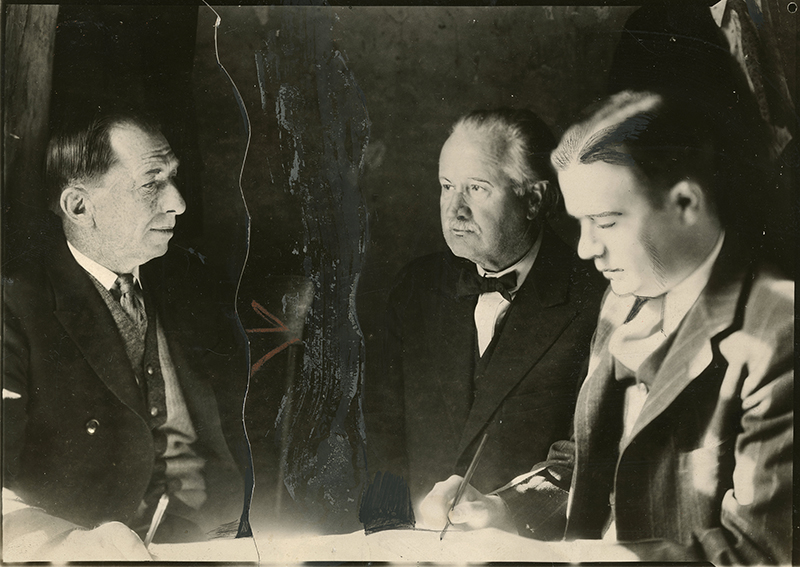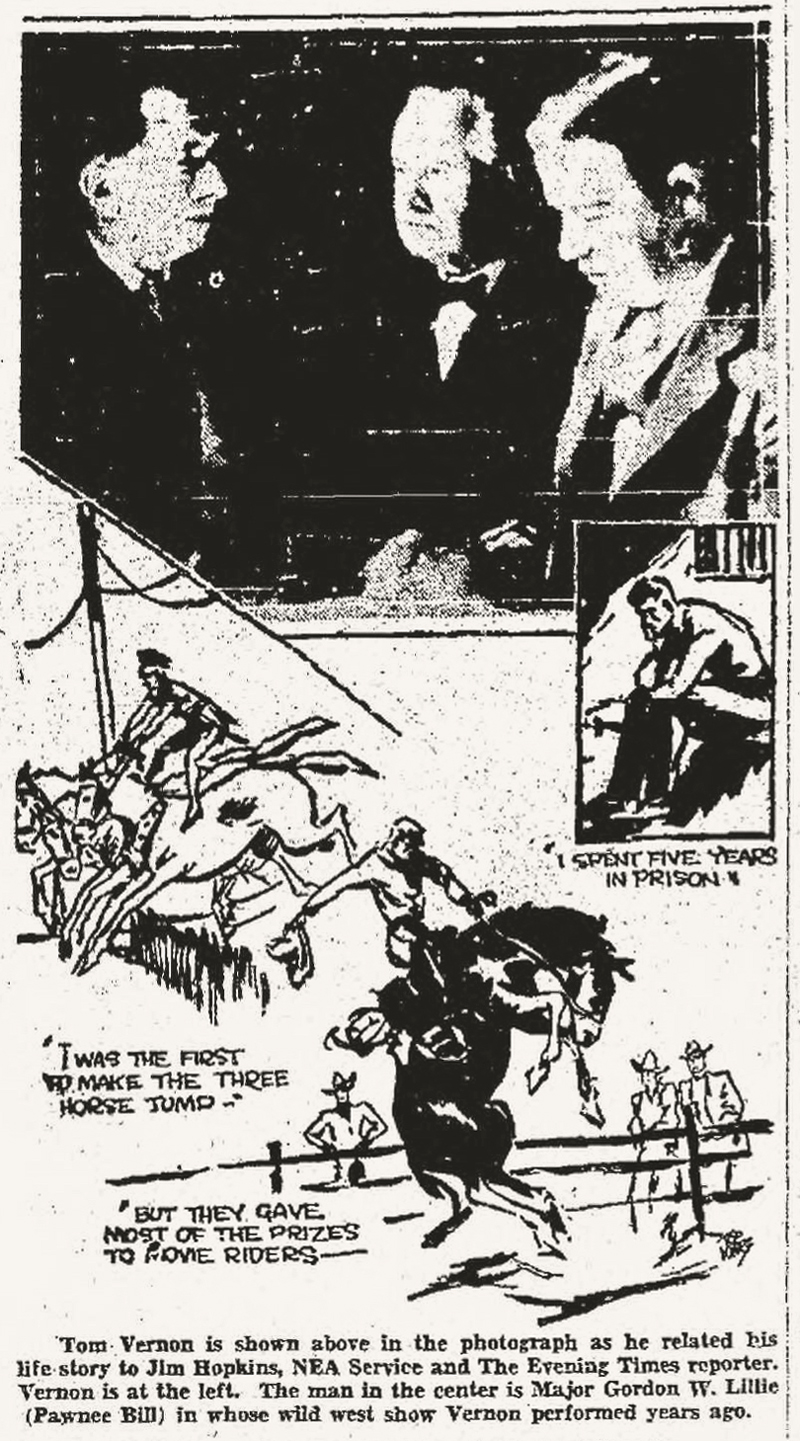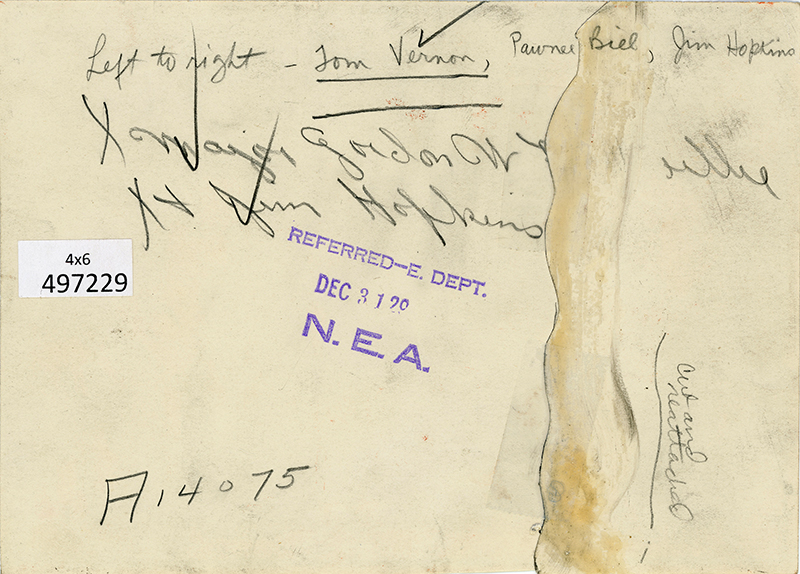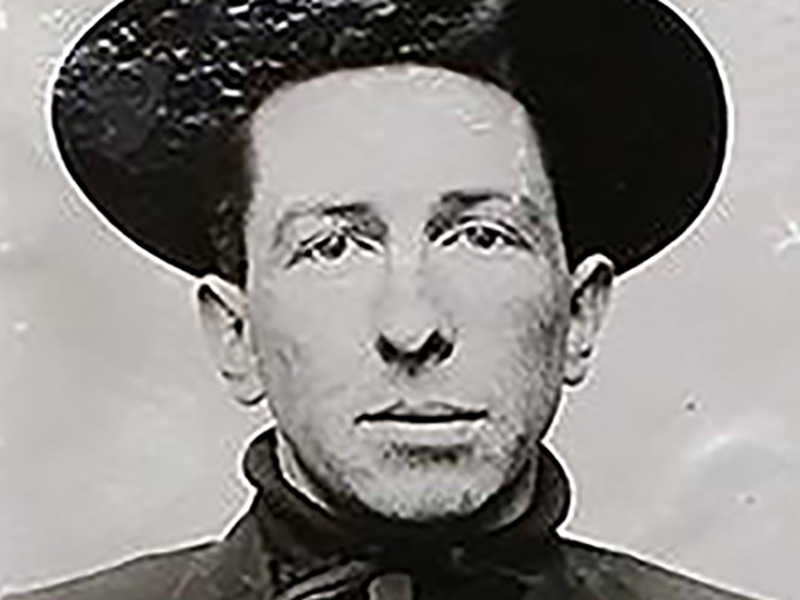|
|
Tom Vernon | Part 3 of 3
Thrills as Cowboy and Dreary Days In Prison Climax The Colorful Career of Tom Vernon.
Newspaper Enterprise Association (NEA) Service
As published in the Cumberland (Md.) Evening Times | January 1, 1930
|

Saugus train robber Tom Vernon, left, sits across a table from Maj. Gordon W. Lillie (Pawnee Bill), center, and journalist Jim Hopkins, writer for the Cumberland (Md.) Evening Times. This is the original photographic print used for the photo illustration (below) that accompanied Part 3 of Hopkins' three-part series on Vernon, which was syndicated by the Newspaper Enterprise Association. The print had been cut along a jagged line and glued to move the subjects closer to each other for the photo illustration. We have reassembled the photograph the way it was originally created in the darkroom. Scroll down to see the writing on the back of the photograph.
Webmaster's note. Justice was swift back in 1929. Tom Vernon robbed the train Nov. 10; he pleaded guilty Dec. 18 and was sentenced the same day to life in prison. This series was published in late December 1929-early January 1930, but the interview was conducted prior to his trial court date. Pawnee Bill Pays Tribute to Alleged Train Robber's Skill as Rider. [Original] Editor's Note: This is the last of three articles by Tom Vernon, one of the few surviving old-time western "bad men," who is now in jail charged with train robbery. In previous articles he has told of his youth in the Wyoming cattle country, his adventure as a wild west show rider and a soldier in China and his first jail sentence.
By Tom (Buffalo) Vernon
After a [sic] got out of that Pennsylvania prison I headed west, and landed with Pawnee Bill's Wild West show as a broncho rider. I was the first fellow to make the three-horse jump and the crowds liked it. I was a pretty good rider. Ask Pawnee Bill about it. (Pawnee Bill — Major Gordon W. Lillie — was in the cell with the reporter while Vernon was telling his story. He nodded approval, "Vernon was the best broncho rider I ever had with my show," he said. "Once he got on a horse there wasn't any bucking him off.") I stayed with Pawnee Bill's show two years. It was there I got my nickname, "Buffalo." The name Vernon, by the way, had been given me by that white man, Pete, on the Sioux reservation when I was a kid. In 1908 we landed in California. I quit the show and went to work for a man who owned a livery stable in Cement, Calif.[1] The job was all right; but one day I had a fight with a constable, and I skipped town, taking about $60 of the livery stable money with me. I wandered to Winnemucca, Nev., and got a job as a cowboy on a big ranch. I got along fine, until one day a horse fell on me and broke my leg. They took me to a doctor in Minnemucca — and there were posters up in the town, offering a reward for me. The town marshal recognized me, and I was taken back to California. My former boss wanted to drop the charges. But his wife didn't like me — she claimed I used to get him drunk — and I got four years in San Quentin prison.
I took to punching cattle again. I roamed all over the west. Finally I landed with a rodeo outfit, making my first appearance at the big Pendleton, Ore., roundup. While there I loaned a big, raw-boned cowboy 10 bucks so he could enter the broncho-riding contest. He was Hoot Gibson, and that was the start of the career that made him a famous movie star.[2] Well, I wandered up and down California in the rodeos, but I didn't have much luck. Most of the judges were moving picture men, and they gave prizes to the movie riders, so's to build up their reputations. I managed to keep going, though, until the World War began. Then I decided to go to Canada and join the army. I got as far as East St. Louis where I got a job for the English government buying horses and mules for their army. I got along all right until I bought a little roan mare, which suited me so much I kept her for myself. They caught me, and I drew another term in prison. I served it in Ohio. After I'd served 16 months, Governor James M. Cox visited the prison. The chaplain took him to my cell, and I told him my story. I guess it interested him; anyhow, he gave me a pardon.[3] I got out in June of 1917, and rightaway I joined the U.S. cavalry — for the third time. They sent me to San Antonio, where I was put in charge of the remount station. I spent a year there, leaving the army in 1919. Then I headed west again. I broke into the movies, doubling for big stars that couldn't ride, and I thought I was sitting pretty — until one day the foreman of a ranch had me arrested for stealing his horse. As a matter of fact I'd paid for the horse, but I couldn't prove it, and I got ten years in Folsom prison. I served two and a half years before I was paroled. When I got out I worked as a janitor. I had good luck, and made a killing on the horses at Tiajuana [sic], so I had a big bank account. But I wasn't used to handling money, and first thing I knew I got arrested for being $500 overdrawn. They sent me to Folsom again, and I served five years. After I got out of prison I couldn't get a job. My prison record was too much for me. So then— Well, the officers claim that I held up a couple of trains. I'm not talking about those holdups now. When I get into court I'll tell my story. Maybe, if I tell them my life story, they'll think I had a right to be an outlaw. What I finally did do was come here to try to get a job at Pawnee Bill's ranch. And I'd only been here a couple of hours when they arrested me for those two holdups. And there's my story. You can decide for yourself whether I ought to be called one of the bad men of the west. Notes. 1. Cement, Calif., was a company town in today's Fairfield, established by the Pacific Portland Cement Co. It dried up in 1927 and became a ghost town. 2. Buffalo Vernon was a champion bulldogger at Pendleton, but the years in this story don't add up. He says he arrived in California in 1908 and then did a three-year prison stretch followed by two years in the cavalry before rodeoing at Pendleton. But according to the Pendleton Round-Up centennial anthology, Buffalo Vernon participated in the first Round-Up in 1910. "Buffalo Vernon [was a] champion steer bulldogger in 1911 and winner of $75. That year he won money, but the year before he won prestige when he first demonstrated to Pendleton crowds the art of wrestling a steer to the ground and holding its lip between his teeth to keep it down. At the closing night's dance, Vernon must have beamed brighter than the loud yellow shirt that fans tore from his back and ripped into souvenirs" (Pendleton Round-Up at 100, 2010:181). He's not mentioned in the Pendleton book after 1911. We'd almost be inclined to think "our" Tom might have assumed Buffalo Tom's identity, were it not for the corroboration of Pawnee Bill. 3. Cox served nonconsecutive terms as Ohio governor: Jan. 13, 1913, to Jan. 11, 1915; and Jan. 8, 1917, to Jan. 10, 1921.
|
Passengers / Earliest Known 11-10-1929
Daybreak 11-11-1929
Newsreel Footage
Loren Ayers x5
Boynton Story
Pollack Story
LAT 11-11-1929
Vernon Captured
Mugshots 12/1929
Extradition 12-12-1929
AP 12-19-1929
REAL: Tom Vernon Prison Records
REAL: Horse Theft 1920
BOGUS: Tom Vernon Letters 1929-1963
BOGUS: Tom Vernon's Fake Photo ID 1962
BOGUS: Vernon's Own Story in 3 Parts
BOGUS: Cattle Kate Story 12-7-1929
BOGUS: Vernon Retells Story in 1953
BOGUS: Sweetwater Incident 1967
BOGUS Sideshow: Lester F. Mead
'Confessor' 11-1929
REAL: Buffalo Vernon 1884-1939
1957-1958 x3
Pardon 1964
Death Cert. 1967
After the Wreck
No. 5042 x3
|
The site owner makes no assertions as to ownership of any original copyrights to digitized images. However, these images are intended for Personal or Research use only. Any other kind of use, including but not limited to commercial or scholarly publication in any medium or format, public exhibition, or use online or in a web site, may be subject to additional restrictions including but not limited to the copyrights held by parties other than the site owner. USERS ARE SOLELY RESPONSIBLE for determining the existence of such rights and for obtaining any permissions and/or paying associated fees necessary for the proposed use.



























